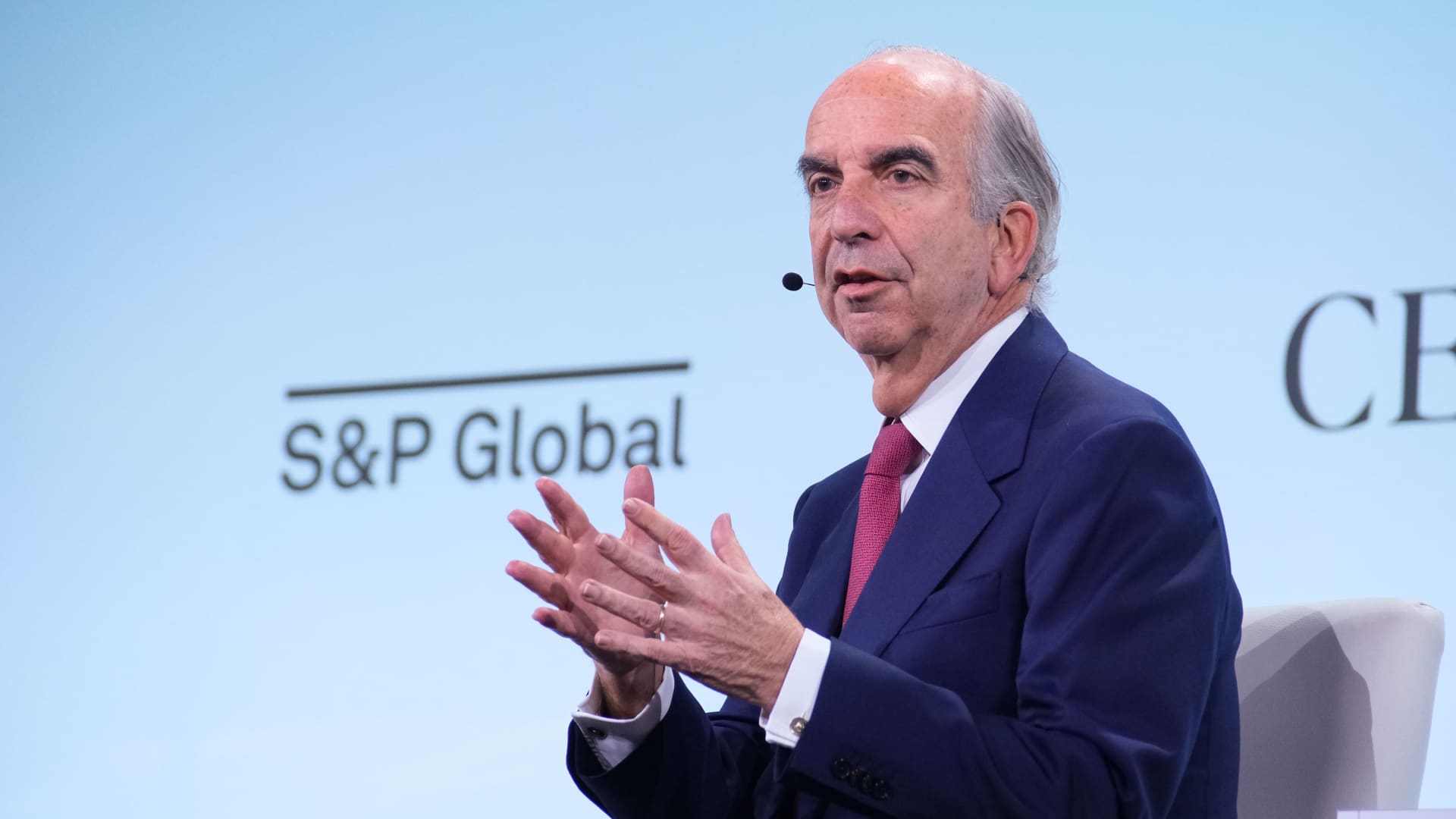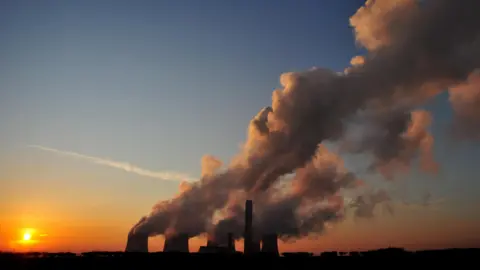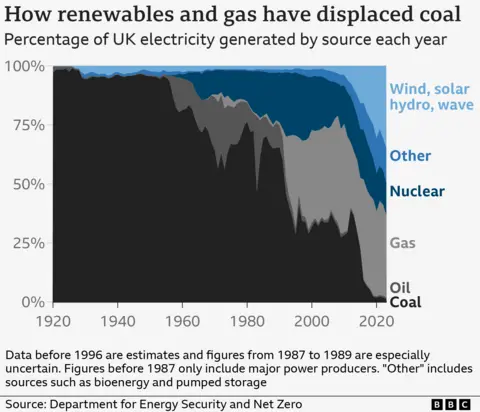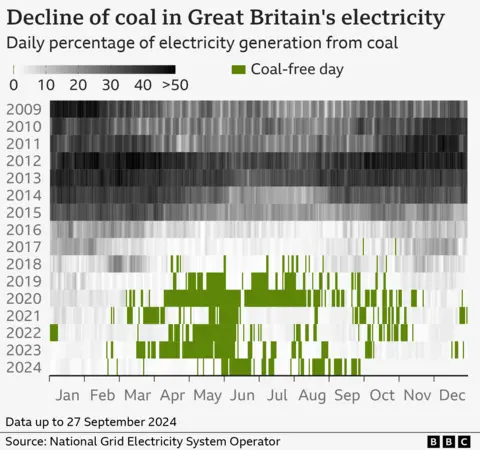Science & Environment
ISS welcomes crew of docked SpaceX capsule

A SpaceX capsule sent to bring back two astronauts stranded on the International Space Station (ISS) has docked.
The Dragon capsule has two empty seats for Butch Wilmore and Suni Williams, who were only meant to be on the ISS for eight days, but were forced to remain there because of a fault discovered during the flight. The pair are now expected to return to Earth in February.
The Dragon capsule lifted off from Cape Canaveral, Florida on Saturday carrying Nasa astronaut Nick Hague and Russian cosmonaut Alexander Gorbunov.
Science & Environment
Disney lands an upgrade — plus, why we’re considering adding to this laggard stock

Every weekday, the CNBC Investing Club with Jim Cramer releases the Homestretch — an actionable afternoon update, just in time for the last hour of trading on Wall Street.
Science & Environment
FTC clears Chevron-Hess deal, bans John Hess from board

John Hess, chief executive officer of Hess Corp., speaks at the 2024 CERAWeek by S&P Global conference in Houston, Texas, US, on Tuesday, March 19, 2024.
F. Carter Smith | Bloomberg | Getty Images
The Federal Trade Commission has banned Hess Corp. CEO John Hess from Chevron‘s board as a condition for the oil companies’ $53 billion merger to move forward.
The FTC on Monday alleged that Hess encouraged OPEC representatives to draw down inventories, which would result in higher oil prices.
“Mr. Hess’s communications with competitors about global oil output and other dimensions of crude oil market competition disqualify him from serving on Chevron’s Board of Directors,” Henry Liu, director of the FTC’s Bureau of Competition, said in a statement Monday.
Hess said the FTC concerns are without merit, describing the CEO’s communications with OPEC as consistent with statements he has made to the U.S. government.
Hess Corp. and Chevron, however, have agreed that they will not appoint Hess to the board in order to facilitate the completion of the merger, according to the companies. Hess will serve as an advisor to Chevron on government relations and “social investments” in Guyana.
The FTC’s decision to allow the deal leaves the companies’ dispute with Exxon Mobil as the final hurdle for the transaction to close. Exxon has filed claims with an arbitration panel claiming a right of first refusal over Hess’ lucrative oil assets in Guyana.
If the arbitration panel rules in Exxon’s favor, the Chevron-Hess deal will not close. Chevron and Hess have said they are confident that panel will rule in their favor.
This is a developing story. Please check back for updates.
Science & Environment
TD sees one stock as biggest industrial beneficiary of nuclear revival
Science & Environment
South Dakota opts out of Inflation Reduction Act energy rebates

Owngarden | Moment | Getty Images
A handful of states have rolled out rebates to consumers who make their homes more energy-efficient, just months after New York became the first state to do so, in May.
Meanwhile, South Dakota officials in August declined the federal funding, which is tied to two new programs created by the Inflation Reduction Act, a landmark climate law enacted in 2022.
The IRA earmarked $8.8 billion for consumers via two Home Energy Rebates programs.
Consumers can access up to $8,000 of Home Efficiency Rebates, and up to $14,000 of Home Electrification and Appliance Rebates.
More from Personal Finance:
Take a look inside a $1.1 million ‘zero emissions’ home
How EVs and gasoline cars compare on total cost
How to buy renewable energy from your electric utility
Together, the two rebate programs aim to defray — or in some cases fully offset — the cost of retrofitting homes and upgrading appliances to be more energy-efficient. Such tweaks can help consumers cut their utility bills while also reducing planet-warming carbon emissions, officials said.
The two programs have varying rules that determine which consumers are eligible and how much money they can access. In some cases, rebates will depend on household income and a home’s overall energy reduction.
Nearly every state has indicated it will launch a rebate program for residents, according to a U.S. Department of Energy spokesperson.
State officials had an August deadline to officially decline the federal funds. They have a Jan. 31, 2025 deadline to submit a program application to the DOE.
South Dakota is the only state so far to have signaled publicly that it won’t administer the rebates.
“With good faith, we did look into this,” Jim Terwilliger, commissioner of the South Dakota Bureau of Finance and Management, said during a July 30 appropriations hearing. “We just don’t believe that it’s the right thing for South Dakota.”
Here are the states that have applied
States, which administer the federal funds, have some leeway relative to program design. They must apply for funding and can distribute rebates to consumers after their application is approved.
New York launched the first phase of its rebates May 30.
Five others — Arizona, Maine, New Mexico, Rhode Island and Wisconsin — have since launched rebate programs, too, according to U.S. Department of Energy data as of Sept. 24.
“I’m expecting more and more to roll out,” said Kara Saul-Rinaldi, president and CEO of AnnDyl Policy Group, a consulting firm focused on climate and energy policy.

Many more states, as well as Washington, D.C., have submitted applications or had them approved, according to DOE data: California, Colorado, Connecticut, Delaware, Florida, Georgia, Hawaii, Illinois, Indiana, Michigan, Minnesota, New Jersey, New Hampshire, Massachusetts, North Carolina, Oregon, Tennessee, Vermont, Washington and West Virginia.
Together, these 26 states plus the District of Columbia have applied for $4 billion in total funding so far, the DOE said.
The rebates are a new program, and “complex government programs like these take time and coordination to set up,” according to a DOE spokesperson.
“The Inflation Reduction Act put states in charge of designing and implementing Home Energy Rebate programs that fit their local needs,” the spokesperson wrote in an e-mail. “As each state has different resources and capabilities, each state’s timeline will be different.”
South Dakota is not participating
South Dakota Gov. Kristi Noem at the Republican National Convention on July 15, 2024.
Scott Olson | Getty Images News | Getty Images
However, South Dakota officials in August signaled they wouldn’t participate, the lone state so far to decline the federal rebate funding.
“South Dakota will have no part in facilitating the Green New Deal,” Ian Fury, a spokesperson for Gov. Kristi Noem, a Republican, said in an e-mailed statement.
States had an Aug. 16, 2024 deadline to officially decline the funds.
“We don’t think the administrative burden and the expense of administering a program like that is the appropriate thing to do, and we generally disagree with the policy,” Terwilliger, of the South Dakota Bureau of Finance and Management, said in a July hearing.
The Inflation Reduction Act allows states to use up to 20% of its funding for administrative purposes.
Fifty-one states and territories have applied to DOE for early administrative funding, the agency said.
The $68.6 million of federal money that had been set aside for South Dakota rebates will be redistributed among participating states.
Fury also noted this isn’t the first time South Dakota has rejected federal spending. It was the only state to reject extended unemployment benefits in 2020 during the Covid-19 pandemic, Fury said.
The Green New Deal is a climate-change policy initiative supported by congressional Democrats starting around 2019. Bipartisan legislation to create an energy rebate program had existed almost a decade earlier, like the Home Star Energy Retrofit Act in 2010.
The concept of consumer rebates tied to energy efficiency “predates the Green New Deal by many years,” said Saul-Rinaldi.
Florida reverses course
It appears Florida officials reversed course from their original stance on the rebates.
Republican Gov. Ron DeSantis in 2023 had vetoed the state’s authority to spend about $5 million of federal funds to administer the energy rebate program. At the time, a spokesperson for the state’s Department of Agriculture and Consumer Services told CNBC that Florida wouldn’t be applying for the rebates as a result.
Florida Gov. Ron DeSantis at the Republican National Convention on July 16, 2024.
Robert Gauthier | Los Angeles Times | Getty Images
Now, Florida is preparing for a soft launch of the rebate programs in late 2024 and a full launch in early 2025, according to information on a state website.
A spokesperson for the Department of Agriculture and Consumer Services didn’t return a request for comment on the change in position.
‘Every state is approaching [its program] differently’
At a high level, consumers will be able to get the rebates at the point of sale, when they buy an appliance directly from a retailer or from a qualified contractor who’s helping a household complete an efficiency project.
“Every state is approaching [its program] differently, for many reasons,” Saul-Rinaldi said.
Many are rolling them out in phases. For example, New Mexico is starting by offering a $1,600 rebate for low-income consumers in single-family homes who buy insulation from a participating retailer.
Similar to other states, qualifying New Mexico residents will be able to later access additional rebates such as:
- $8,000 for an ENERGY STAR-certified electric heat pump for space heating and cooling;
- $4,000 for an electrical panel;
- $2,500 for electrical wiring;
- $1,750 for an ENERGY STAR-certified electric heat pump water heater;
- $1,600 for air sealing; and
- $840 for an ENERGY STAR-certified electric heat pump clothes dryer and/or an electric stove.
Consumers and contractors should consult their state energy department website to learn more about their specific programs and eligibility, Saul-Rinaldi said.
The U.S. Energy Department suggests households don’t wait to accomplish necessary home energy upgrades or projects if their state hasn’t formally rolled out rebates. They may be eligible for other federal programs, “including tax credits, the Weatherization Assistance Program, and other state, local, and utility programs,” the agency said.
Science & Environment
WTI on pace for third monthly loss


U.S. crude oil prices are on pace for a third monthly loss in a row in September as rising supplies from OPEC+ and weak demand in China haunt the market.
The U.S. benchmark has declined more than 7% for the month, while global benchmark Brent has fallen about 9%.
“Oil markets are experiencing a panic attack,” Amarpreet Singh, energy analyst at Barclays, told clients in a Friday note. “Balances are set to loosen next year, but concerns are likely overdone.”
Barclays expects Brent to average $85 in 2025.
Here are Monday’s energy prices:
- West Texas Intermediate November contract: $68.23, up 5 cents, or 0.07%. Year to date, U.S. crude oil has fallen nearly 5%.
- Brent November contract: $71.69 per barrel, down 29 cents, or 0.4%. Year to date, the global benchmark has declined nearly 7%.
- RBOB Gasoline October contract: $1.954 per gallon, up 0.05%. Year to date, gasoline has pulled back about 7%.
- Natural Gas November contract: $2.896 per thousand cubic feet, down 0.21%. Year to date, gas has gained about 16%.
Oil prices remain under pressure in part because OPEC+ plans to begin increasing production in December, and as demand in China, the world’s largest crude importer, remains soft.
Prices are finding little support from red hot tensions in the Middle East even after Israel killed Hezbollah leader Hassan Nasrallah in an airstrike in Beirut on Friday. The Netanyahu government is pummeling the Iran-backed militia group, with concerns growing that Israel might launch a ground operation in Lebanon.
“We believe that this price action reflects that the geopolitical risk premium remains limited [amid] market expectations of potentially higher oil supply” from Libya and Saudi Arabia, Daan Struyven, head oil analyst at Goldman Sachs, told clients in a Sunday note.
Science & Environment
UK to close last coal power station after 142 years

 PA Media
PA MediaThe UK is about to stop producing any electricity from burning coal – ending its 142-year reliance on the fossil fuel.
The country’s last coal power station, at Ratcliffe-on-Soar, finishes operations on Monday after running since 1968.
This marks a major milestone in the country’s ambitions to reduce its contribution to climate change. Coal is the dirtiest fossil fuel producing the most greenhouse gases when burnt.
Minister for Energy Michael Shanks said: “We owe generations a debt of gratitude as a country.”
The UK was the birthplace of coal power, and from tomorrow it becomes the first major economy to give it up.
“It’s a really remarkable day, because Britain, after all, built her whole strength on coal, that is the industrial revolution,” said Lord Deben – the longest serving environment secretary.
The first coal-fired power station in the world, the Holborn Viaduct power station, was built in 1882 in London by the inventor Thomas Edison – bringing light to the streets of the capital.
 Oxford Science Archive/Getty Images
Oxford Science Archive/Getty ImagesFrom that point through the first half of the twentieth century, coal provided pretty much all of the UK’s electricity, powering homes and businesses.
But from the 1960s things began to change. New discoveries of oil and gas were made in the North Sea offering a new, cheap source of energy, whilst the country’s coal mines were becoming less globally competitive and successive governments began closing them.
In the early 1990s, coal began to be forced out of the electricity mix by gas, but coal still remained a crucial component of the UK grid for the next two decades.
In 2012, it still generated 39% of the UK’s power.

The growth of renewables
But the science around climate change was growing – it was clear that the world’s greenhouse gas emissions needed to be reduced and as the dirtiest fossil fuel, coal was a major target.
In 2008, the UK established its first legally binding climate targets and in 2015 the then-energy and climate change secretary, Amber Rudd, told the world the UK would be ending its use of coal power within the next decade.
Dave Jones, director of global insights at Ember, an independent energy think tank, said this really helped to “set in motion” the end of coal by providing a clear direction of travel for the industry.
But it also showed leadership and set a benchmark for other countries to follow, according to Lord Deben.
“I think it’s made a big difference, because you need someone to point to and say, ‘There, they’ve done it. Why can’t we do it?’”, he said.
In 2010, renewables generated just 7% of the UK’s power. In the first half of 2024, this had grown to more than 50% – a new record.
The rapid growth of green power meant that coal could even be switched off completely for short periods, beginning in 2017.

The growth of renewables has been so successful that the target date for ending coal power was brought forward a year, and on Monday, Ratcliffe-on-Soar, was set to close for the last time.
Chris Smith worked at the plant for 28 years in the environment and chemistry team. She said: “It is a very momentous day. The plant has always been running and we’ve always been doing our best to keep it operating….It is a very sad moment.”
Lord Deben served in former prime minister Margaret Thatcher’s government when many of the UK’s coal mines were closed and thousands of workers lost their jobs. He said lessons had to be learnt from that for current workers in the fossil fuel industry.
“I’m particularly keen on the way in which this Government, and indeed the previous Government, is trying to make sure that the new jobs, of which there are very many green jobs, go to the places which are being damaged by the changes.
“So in the North Sea oil areas, that’s exactly where we should be doing carbon capture and storage, it’s where we should be putting wind and solar power,” he said.
Challenges ahead
Although coal is a very polluting source of energy, its benefit has been in being available at all times – unlike wind and solar which are limited by weather conditions.
Kayte O’Neill, the chief operating officer at the Energy System Operator – the body overseeing the UK’s electricity system – said: “There is a whole load of innovation required to help us ensure the stability of the grid. Keeping the lights on in a secure way.”
A crucial technology providing that stability Kayte O’Neill spoke of is battery technology.
Dr Sylwia Walus, research programme manager at the Faraday Institution, said that there has been significant progress in the science of batteries.
“There is always scope for a new technology, but more focus these days is really how to make it more sustainable and cheaper in production,” she said.
To achieve this the UK needs to become more independent of China in producing its own batteries and bringing in skilled workers for this purpose, she explained.
Additional reporting by Miho Tanaka and Justin Rowlatt
-

 Womens Workouts1 week ago
Womens Workouts1 week ago3 Day Full Body Women’s Dumbbell Only Workout
-

 Technology2 weeks ago
Technology2 weeks agoWould-be reality TV contestants ‘not looking real’
-

 Science & Environment2 weeks ago
Science & Environment2 weeks ago‘Running of the bulls’ festival crowds move like charged particles
-

 News1 week ago
News1 week agoOur millionaire neighbour blocks us from using public footpath & screams at us in street.. it’s like living in a WARZONE – WordupNews
-

 Science & Environment2 weeks ago
Science & Environment2 weeks agoHow to wrap your mind around the real multiverse
-

 Science & Environment2 weeks ago
Science & Environment2 weeks agoHyperelastic gel is one of the stretchiest materials known to science
-

 Science & Environment2 weeks ago
Science & Environment2 weeks agoMaxwell’s demon charges quantum batteries inside of a quantum computer
-

 Science & Environment2 weeks ago
Science & Environment2 weeks agoSunlight-trapping device can generate temperatures over 1000°C
-

 Science & Environment2 weeks ago
Science & Environment2 weeks agoHow to unsnarl a tangle of threads, according to physics
-

 Science & Environment2 weeks ago
Science & Environment2 weeks agoLiquid crystals could improve quantum communication devices
-

 Science & Environment2 weeks ago
Science & Environment2 weeks agoPhysicists are grappling with their own reproducibility crisis
-

 Science & Environment2 weeks ago
Science & Environment2 weeks agoITER: Is the world’s biggest fusion experiment dead after new delay to 2035?
-

 News2 weeks ago
News2 weeks agoYou’re a Hypocrite, And So Am I
-

 Sport2 weeks ago
Sport2 weeks agoJoshua vs Dubois: Chris Eubank Jr says ‘AJ’ could beat Tyson Fury and any other heavyweight in the world
-

 Science & Environment2 weeks ago
Science & Environment2 weeks agoQuantum ‘supersolid’ matter stirred using magnets
-

 Science & Environment2 weeks ago
Science & Environment2 weeks agoWhy this is a golden age for life to thrive across the universe
-

 Science & Environment2 weeks ago
Science & Environment2 weeks agoQuantum forces used to automatically assemble tiny device
-

 Science & Environment2 weeks ago
Science & Environment2 weeks agoCaroline Ellison aims to duck prison sentence for role in FTX collapse
-

 Science & Environment2 weeks ago
Science & Environment2 weeks agoNuclear fusion experiment overcomes two key operating hurdles
-

 Science & Environment2 weeks ago
Science & Environment2 weeks agoLaser helps turn an electron into a coil of mass and charge
-

 Science & Environment2 weeks ago
Science & Environment2 weeks agoTime travel sci-fi novel is a rip-roaringly good thought experiment
-

 Science & Environment2 weeks ago
Science & Environment2 weeks agoNerve fibres in the brain could generate quantum entanglement
-

 CryptoCurrency2 weeks ago
CryptoCurrency2 weeks agoCardano founder to meet Argentina president Javier Milei
-

 Science & Environment1 week ago
Science & Environment1 week agoMeet the world's first female male model | 7.30
-

 News2 weeks ago
News2 weeks agoIsrael strikes Lebanese targets as Hizbollah chief warns of ‘red lines’ crossed
-

 Womens Workouts1 week ago
Womens Workouts1 week agoBest Exercises if You Want to Build a Great Physique
-

 CryptoCurrency2 weeks ago
CryptoCurrency2 weeks agoEthereum is a 'contrarian bet' into 2025, says Bitwise exec
-

 Science & Environment2 weeks ago
Science & Environment2 weeks agoWhy we need to invoke philosophy to judge bizarre concepts in science
-

 CryptoCurrency2 weeks ago
CryptoCurrency2 weeks agoDZ Bank partners with Boerse Stuttgart for crypto trading
-

 Womens Workouts1 week ago
Womens Workouts1 week agoEverything a Beginner Needs to Know About Squatting
-

 Womens Workouts1 week ago
Womens Workouts1 week ago3 Day Full Body Toning Workout for Women
-

 News2 weeks ago
News2 weeks agoBrian Tyree Henry on voicing young Megatron, his love for villain roles
-

 News2 weeks ago
News2 weeks ago▶️ Media Bias: How They Spin Attack on Hezbollah and Ignore the Reality
-

 Science & Environment2 weeks ago
Science & Environment2 weeks agoA slight curve helps rocks make the biggest splash
-

 Science & Environment2 weeks ago
Science & Environment2 weeks agoQuantum time travel: The experiment to ‘send a particle into the past’
-

 CryptoCurrency2 weeks ago
CryptoCurrency2 weeks agoBitcoin miners steamrolled after electricity thefts, exchange ‘closure’ scam: Asia Express
-

 CryptoCurrency2 weeks ago
CryptoCurrency2 weeks agoDorsey’s ‘marketplace of algorithms’ could fix social media… so why hasn’t it?
-

 CryptoCurrency2 weeks ago
CryptoCurrency2 weeks agoRedStone integrates first oracle price feeds on TON blockchain
-

 CryptoCurrency2 weeks ago
CryptoCurrency2 weeks agoBitcoin bulls target $64K BTC price hurdle as US stocks eye new record
-

 CryptoCurrency2 weeks ago
CryptoCurrency2 weeks agoBlockdaemon mulls 2026 IPO: Report
-

 CryptoCurrency2 weeks ago
CryptoCurrency2 weeks agoCoinbase’s cbBTC surges to third-largest wrapped BTC token in just one week
-

 News1 week ago
News1 week agoFour dead & 18 injured in horror mass shooting with victims ‘caught in crossfire’ as cops hunt multiple gunmen
-

 Travel6 days ago
Travel6 days agoDelta signs codeshare agreement with SAS
-

 Politics5 days ago
Politics5 days agoHope, finally? Keir Starmer’s first conference in power – podcast | News
-

 Sport2 weeks ago
Sport2 weeks agoUFC Edmonton fight card revealed, including Brandon Moreno vs. Amir Albazi headliner
-

 Science & Environment2 weeks ago
Science & Environment2 weeks agoA new kind of experiment at the Large Hadron Collider could unravel quantum reality
-

 Technology2 weeks ago
Technology2 weeks agoiPhone 15 Pro Max Camera Review: Depth and Reach
-

 Science & Environment2 weeks ago
Science & Environment2 weeks agoHow one theory ties together everything we know about the universe
-

 Science & Environment2 weeks ago
Science & Environment2 weeks agoBeing in two places at once could make a quantum battery charge faster
-

 CryptoCurrency2 weeks ago
CryptoCurrency2 weeks agoCrypto scammers orchestrate massive hack on X but barely made $8K
-

 Science & Environment2 weeks ago
Science & Environment2 weeks agoTiny magnet could help measure gravity on the quantum scale
-

 Science & Environment2 weeks ago
Science & Environment2 weeks agoFuture of fusion: How the UK’s JET reactor paved the way for ITER
-

 Science & Environment2 weeks ago
Science & Environment2 weeks agoHow do you recycle a nuclear fusion reactor? We’re about to find out
-

 CryptoCurrency2 weeks ago
CryptoCurrency2 weeks agoLow users, sex predators kill Korean metaverses, 3AC sues Terra: Asia Express
-

 CryptoCurrency2 weeks ago
CryptoCurrency2 weeks agoSEC asks court for four months to produce documents for Coinbase
-

 CryptoCurrency2 weeks ago
CryptoCurrency2 weeks ago‘No matter how bad it gets, there’s a lot going on with NFTs’: 24 Hours of Art, NFT Creator
-
Business2 weeks ago
How Labour donor’s largesse tarnished government’s squeaky clean image
-

 News2 weeks ago
News2 weeks agoBrian Tyree Henry on voicing young Megatron, his love for villain roles
-

 Womens Workouts1 week ago
Womens Workouts1 week agoHow Heat Affects Your Body During Exercise
-

 Womens Workouts1 week ago
Womens Workouts1 week agoKeep Your Goals on Track This Season
-

 News2 weeks ago
News2 weeks agoChurch same-sex split affecting bishop appointments
-

 Technology2 weeks ago
Technology2 weeks agoFivetran targets data security by adding Hybrid Deployment
-

 CryptoCurrency2 weeks ago
CryptoCurrency2 weeks ago$12.1M fraud suspect with ‘new face’ arrested, crypto scam boiler rooms busted: Asia Express
-

 Science & Environment2 weeks ago
Science & Environment2 weeks agoUK spurns European invitation to join ITER nuclear fusion project
-

 CryptoCurrency2 weeks ago
CryptoCurrency2 weeks agoDecentraland X account hacked, phishing scam targets MANA airdrop
-

 CryptoCurrency2 weeks ago
CryptoCurrency2 weeks agoCertiK Ventures discloses $45M investment plan to boost Web3
-

 CryptoCurrency2 weeks ago
CryptoCurrency2 weeks agoBeat crypto airdrop bots, Illuvium’s new features coming, PGA Tour Rise: Web3 Gamer
-

 CryptoCurrency2 weeks ago
CryptoCurrency2 weeks agoTelegram bot Banana Gun’s users drained of over $1.9M
-

 CryptoCurrency2 weeks ago
CryptoCurrency2 weeks ago‘Silly’ to shade Ethereum, the ‘Microsoft of blockchains’ — Bitwise exec
-

 CryptoCurrency2 weeks ago
CryptoCurrency2 weeks agoEthereum falls to new 42-month low vs. Bitcoin — Bottom or more pain ahead?
-
Business2 weeks ago
Thames Water seeks extension on debt terms to avoid renationalisation
-
Politics2 weeks ago
‘Appalling’ rows over Sue Gray must stop, senior ministers say | Sue Gray
-

 Science & Environment1 week ago
Science & Environment1 week agoCNN TÜRK – 🔴 Canlı Yayın ᴴᴰ – Canlı TV izle
-

 News1 week ago
News1 week agoWhy Is Everyone Excited About These Smart Insoles?
-

 Politics2 weeks ago
Politics2 weeks agoTrump says he will meet with Indian Prime Minister Narendra Modi next week
-

 Science & Environment2 weeks ago
Science & Environment2 weeks agoSingle atoms captured morphing into quantum waves in startling image
-

 Technology2 weeks ago
Technology2 weeks agoCan technology fix the ‘broken’ concert ticketing system?
-

 Science & Environment2 weeks ago
Science & Environment2 weeks agoHow Peter Higgs revealed the forces that hold the universe together
-

 Health & fitness2 weeks ago
Health & fitness2 weeks agoThe secret to a six pack – and how to keep your washboard abs in 2022
-

 CryptoCurrency2 weeks ago
CryptoCurrency2 weeks ago2 auditors miss $27M Penpie flaw, Pythia’s ‘claim rewards’ bug: Crypto-Sec
-

 CryptoCurrency2 weeks ago
CryptoCurrency2 weeks agoJourneys: Robby Yung on Animoca’s Web3 investments, TON and the Mocaverse
-

 CryptoCurrency2 weeks ago
CryptoCurrency2 weeks agoLouisiana takes first crypto payment over Bitcoin Lightning
-

 CryptoCurrency2 weeks ago
CryptoCurrency2 weeks ago‘Everything feels like it’s going to shit’: Peter McCormack reveals new podcast
-

 Science & Environment2 weeks ago
Science & Environment2 weeks agoA tale of two mysteries: ghostly neutrinos and the proton decay puzzle
-

 CryptoCurrency2 weeks ago
CryptoCurrency2 weeks agoSEC sues ‘fake’ crypto exchanges in first action on pig butchering scams
-

 CryptoCurrency2 weeks ago
CryptoCurrency2 weeks agoBitcoin price hits $62.6K as Fed 'crisis' move sparks US stocks warning
-

 CryptoCurrency2 weeks ago
CryptoCurrency2 weeks agoVonMises bought 60 CryptoPunks in a month before the price spiked: NFT Collector
-

 CryptoCurrency2 weeks ago
CryptoCurrency2 weeks agoVitalik tells Ethereum L2s ‘Stage 1 or GTFO’ — Who makes the cut?
-

 News2 weeks ago
News2 weeks agoBrian Tyree Henry on his love for playing villains ahead of “Transformers One” release
-

 News1 week ago
News1 week agoBangladesh Holds the World Accountable to Secure Climate Justice
-

 Womens Workouts1 week ago
Womens Workouts1 week agoWhich Squat Load Position is Right For You?
-

 TV1 week ago
TV1 week agoCNN TÜRK – 🔴 Canlı Yayın ᴴᴰ – Canlı TV izle
-

 Technology7 days ago
Technology7 days agoRobo-tuna reveals how foldable fins help the speedy fish manoeuvre
-

 Technology2 weeks ago
Technology2 weeks agoIs carbon capture an efficient way to tackle CO2?
-

 Science & Environment2 weeks ago
Science & Environment2 weeks agoThe physicist searching for quantum gravity in gravitational rainbows
-

 Fashion Models2 weeks ago
Fashion Models2 weeks agoMixte
-

 Politics2 weeks ago
Politics2 weeks agoLabour MP urges UK government to nationalise Grangemouth refinery
-

 Health & fitness2 weeks ago
Health & fitness2 weeks agoThe maps that could hold the secret to curing cancer
-

 CryptoCurrency2 weeks ago
CryptoCurrency2 weeks agoHelp! My parents are addicted to Pi Network crypto tapper
-

 CryptoCurrency2 weeks ago
CryptoCurrency2 weeks agoCZ and Binance face new lawsuit, RFK Jr suspends campaign, and more: Hodler’s Digest Aug. 18 – 24



You must be logged in to post a comment Login